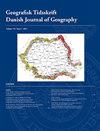利用热红外和RGB-NIR遥感技术对河岸低地的瓷砖排水口和地表流量进行定位
IF 1.1
4区 社会学
Q4 ENVIRONMENTAL STUDIES
Geografisk Tidsskrift-Danish Journal of Geography
Pub Date : 2019-01-02
DOI:10.1080/00167223.2019.1573408
引用次数: 7
摘要
农田人工排水是水和养分的主要流动途径,可能会导致受水水体富营养化问题。几项研究表明,如果存在河岸低地(冲积平原、湿地、草甸),可以作为具有高营养保留能力的缓冲区。为了评估排水集水区的水和养分流在河岸低地的命运,了解作为养分输入来源的排水出口的位置至关重要。利用热红外(TIR)遥感调查,我们在河岸低地确定了潜在的瓷砖排水出口。我们还应用归一化分化植被指数(NDVI)方法来说明如何利用免费宽带RGB-NIR数据识别瓷砖排水口。通过现场目测,对鉴定出的出口位置进行了验证。我们的研究发现,在评估水源输入时,TIR遥感是一个强有力的工具。NDVI也适用,但是背景值变化很大,使得出口难以定位。这些结果可以应用于通过瓷砖排水的水运动和溶质运输的研究,以及通过瓷砖排水的输入区域的知识非常重要的模型研究。本文章由计算机程序翻译,如有差异,请以英文原文为准。
Locating tile drainage outlets and surface flow in riparian lowlands using thermal infrared and RGB-NIR remote sensing
ABSTRACT Artificial drainage of agricultural fields represents a major flow path way of both water and nutrients which may contribute to eutrophication issues in the recipient waters. Several studies have shown that riparian lowlands (alluvial plains, wetlands, meadows), if present, may act as buffer zones with high nutrient retention capacities. To assess the fate of water and nutrient flow in riparian lowlands in tile drained catchments, it is essential to know the locations of tile drainage outlets as sources of nutrient input. Using a thermal infrared (TIR) remote-sensing survey, we identified potential tile drainage outlets in a riparian lowland. We also applied a normalized differentiated vegetation index (NDVI) approach to illustrate how tile drainage outlets can be identified with free broadband RGB-NIR data. The positions of identified outlets were validated in the field by visual observation. Our study finds that TIR remote sensing is a strong tool when assessing the sources of water input. NDVI is also applicable, however the background values are very variable making the outlets difficult to locate. The results can be applied in studies of water movement and solute transport via tile drainage as well as model studies where knowledge of input areas through tile drainage is of great importance.
求助全文
通过发布文献求助,成功后即可免费获取论文全文。
去求助
来源期刊
CiteScore
5.20
自引率
0.00%
发文量
5
期刊介绍:
DJG is an interdisciplinary, international journal that publishes peer reviewed research articles on all aspects of geography. Coverage includes such topics as human geography, physical geography, human-environment interactions, Earth Observation, and Geographical Information Science. DJG also welcomes articles which address geographical perspectives of e.g. environmental studies, development studies, planning, landscape ecology and sustainability science. In addition to full-length papers, DJG publishes research notes. The journal has two annual issues. Authors from all parts of the world working within geography or related fields are invited to publish their research in the journal.

 求助内容:
求助内容: 应助结果提醒方式:
应助结果提醒方式:


